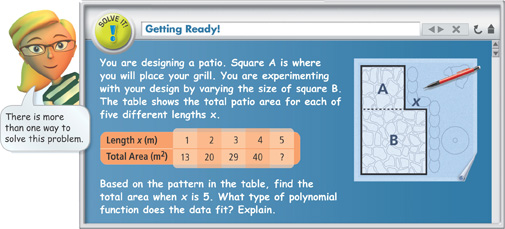5-8 Polynomial Models in the Real World
Objective
To fit data to linear, quadratic, cubic, or quartic models
Polynomial functions can be degree 0 (constant), degree 1 (linear), degree 2 (quadratic), degree 3 (cubic), and so on.
Essential Understanding You can use polynomial functions to model many real-world situations. The behavior of the graphs of polynomial functions of different degrees can suggest what type of polynomial will best fit a particular data set.
You can use a graphing calculator to help you find functions that model the data in the table shown here.
| x | y |
|---|---|
| 0 | 10.1 |
| 5 | 2.8 |
| 10 | 8.1 |
| 15 | 16.0 |
| 20 | 17.8 |
Enter the data into calculator lists L1 and L2. Use three different regressions: LINREG, QUADREG, and CUBICREG.
Graph each regression function and the scatter plot of the data in the same window. For this data, the cubic function appears to be a perfect fit.
Table of Contents
- 5-1 Polynomial Functions
- 5-2 Polynomials, Linear Factors, and Zeros
- 5-3 Solving Polynomial Equations
- 5-4 Dividing Polynomials
- 5-5 Theorems About Roots of Polynomial Equations
- 5-6 The Fundamental Theorem of Algebra
- 5-7 The Binomial Theorem
- 5-8 Polynomial Models in the Real World
- 5-9 Transforming Polynomial Functions






